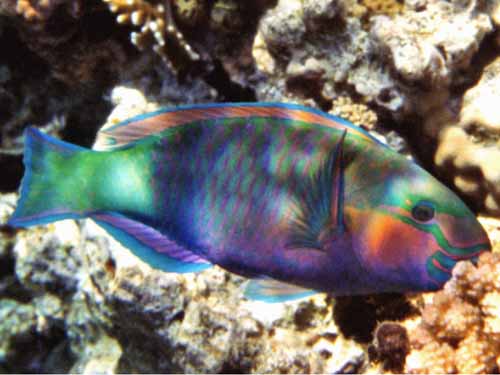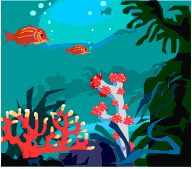Classification
Domain- Eukarya
The Daisy Parrotfish is classified in the Domain of eukarya
because it has cells that contain membrane-bound organelles and
a nucleus with a nuclear membrane.
Kingdom- Animalia
The Kingdom of animalia is
for multicellular organisms that are motile, their cells do not
have cell walls, and they are heterotrophic.
Phylum- Chordata
They are identified as chordates because they have an endostyle, notochord, dorsal
nerve chord, pharyngeal pouches, and a postanal tail all at some
point in their development. All of those characteristics are key
characteristics to identifying chordates.
Class- Actinopterygii
Daisy parrotfish fit into the class, actinopterygii, because it
is a ray-finned spiny fish.
Order- Perciformes
Perciformes, means perch-like fish, which Chlorurus
sordidus is.
 Family- Scaridae
Family- Scaridae
It is classified into the family of scaridae
because this is a family for all parrotfish. It is classified by
beak-like mouths.
Genus- Chlorurus
Chlorurus
translates to green-tail in Latin. As you can see below the
daisy parrotfish does have a green-tail. They are know for being
blue-green fish.
Species- Chlorurus sordidus
Now you know what Chlorurus means for the
rest of the species name, adding onto green-tail is
sordidus which means "filthy". This is a proper name for the daisy parrotfish because of their eating habits. They break off chunks of coral, dropping a few and crushing up the rest into sand. A large parrotfish will release over a ton a sand every year, clouding the water around it. So the parrotfish is a "filthy" fish!
Above is the phylogenic tree of the family labridae based on nuclear and mitochondrial DNA sequences. I made the image above with the guidance of this research article figure: Local phylogenetic divergence and global evolutionary convergence of skull function in reef fishes of the family Labridae. The families scaridae and labridae are very closely related, that is why in the figure above Chlorurus sordidus is seen as apart of the labridae family. All of the species that stem of of scarines are different species of parrotfish. They all have the unique feature of fused teeth forming a beak, which is one of the reasons that they are grouped together. Off of the labridae, all of the sub-classifications are of wrasse fish. A wrasse fish is known to have a symbiotic relationship with a cleaner fish and is usually brightly colored; this describes Chlorurus sordidus perfectly.
Adaptations
All fish are adapted for life in the water.
Their skeletons are a more compact shape so that their bodies
are more streamlined to move through the water.
 For respiration
they have gills on the sides of their bodies which have water
pushed through them by the mouth. Water, full of oxygen, flows
over the gills and blood low in oxygen flows through the gills
in the opposite direction. A concentration gradient is made as
the oxygen is diffused into the bloodstream. This process is
known as "Countercurrent Exchange".
For respiration
they have gills on the sides of their bodies which have water
pushed through them by the mouth. Water, full of oxygen, flows
over the gills and blood low in oxygen flows through the gills
in the opposite direction. A concentration gradient is made as
the oxygen is diffused into the bloodstream. This process is
known as "Countercurrent Exchange".
Juvenile parrotfish are carnivorous because
their teeth are not fully developed yet. Their mouths are small
and contain separated teeth. When they become adults, they
switch to a herbivore lifestyle. At this point, teeth are fused
together to form a shape that looks like a beak. Leading to the
back of the throat are two upper bones and one
lower bone; these
bones enable the parrotfish to crush up the
coral to get out all
of the nutrients possible.
the parrotfish to crush up the
coral to get out all
of the nutrients possible.
As this switch from carnivore to omnivore to herbivore is occurring, their digestive tract must also adapt. Early on is is shorter and more simple, but once they become herbivores their digestive tract must increase in length and complexity. This change occurs because they need to get as much of the nutrients out of the algae as possible, and algae, along with other plants, are very difficult to digest. If you like to learn more about their eating habits venture off to my Nutrition page!